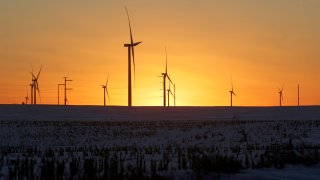
- The USDA will spend $1 billion on projects for farmers, ranchers and forest landowners to use practices that curb climate-changing greenhouse gas emissions or capture and store carbon.
- The investment comes after President Joe Biden called on U.S. farmers to lead the way in offsetting emissions and pledged to slash emissions from the agriculture sector in half by 2030.
- The agriculture sector accounts for more than 10% of U.S. emissions, according to estimates from the Environmental Protection Agency.
The U.S. Department of Agriculture will spend $1 billion on projects for farmers, ranchers and forest landowners to use practices that curb climate-changing greenhouse gas emissions or capture and store carbon, USDA Secretary Tom Vilsack announced Monday.
The investment comes after President Joe Biden called on U.S. farmers to lead the way in offsetting emissions and pledged to slash emissions from the agriculture sector in half by 2030. The sector accounts for more than 10% of U.S. emissions, according to estimates from the Environmental Protection Agency. A range of public and private entities can apply for grants from $5 million to $100 million, the agency said, including state, local and tribal governments, nonprofits, small businesses and colleges.
For many U.S. farmers who have endured major losses from worsening floods, storms and droughts, addressing climate change has become a matter of survival. The United Nations' scientific panel on climate change has warned that humans must change the way they produce food and use land to avoid the worst consequences of climate change.
Get New England news, weather forecasts and entertainment stories to your inbox. Sign up for NECN newsletters.
"They've seen it, they feel it, and they've been hurt by it," Vilsack said on Monday at Lincoln University, a historically Black land-grant university in Jefferson City, Missouri.
Some farmers, ranchers and foresters have already embraced climate-friendly practices that capture existing carbon and store it in soil. However, others are wary of upfront costs and uncertain returns that could vary across different farming operations and locations.
Money Report
"We're trying to incentivize the creation of climate-smart commodities that hold higher value in the marketplace that farmers can generate additional profit from," Vilsack said.
"This is about creating domestic markets that will provide American agriculture and forestry with the resources to do what they know to do best — to feed the world, while serving as great stewards of our land and water."
The USDA's program will focus on projects that implement climate-friendly conservation practices, such as no-till, cover crops and rotational grazing, as well as measure and monitor greenhouse gas emissions from agricultural operations and capture and store carbon.
The agency defines a climate-smart commodity as an agricultural commodity produced using farming, ranching or forestry practices that slash emissions or sequester carbon.
The Partnerships for Climate-Smart Commodities program will take money from the agency's Commodity Credit Corporation, which provides up to $30 billion in annual funding from the the U.S. Treasury to support farm income.






